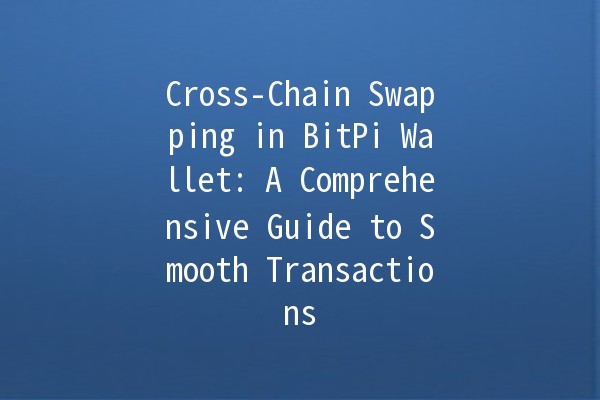
In the everevolving landscape of blockchain and cryptocurrencies, crosschain swapping has emerged as a vital functionality. BitPi Wallet stands out as a promising solution for users looking to navigate this intricate transaction process seamlessly. In this article, we will delve into the essentials of crosschain swapping within the BitPi Wallet, providing practical tips and insights aimed at enhancing your productivity and comfort in managing your digital assets.
Understanding CrossChain Swapping
Crosschain swapping enables users to exchange different cryptocurrencies across various blockchain platforms without the need for a centralized exchange. The rise of decentralized finance (DeFi) has catalyzed the demand for such interoperability, allowing users to optimize their asset management and portfolio diversification.
Benefits of CrossChain Swapping
Tips for Effective CrossChain Swapping in BitPi Wallet

To make the most of your crosschain swapping experience, here are some actionable tips you can incorporate:
Understanding which cryptocurrencies are supported for crosschain swaps in BitPi Wallet is crucial. Before initiating a swap, ensure that both the coins you wish to trade are compatible. You can usually find this information in the wallet's documentation or on the main interface.
Example:
If you want to swap Bitcoin for Ethereum, doublecheck that these specific pairs are supported by the BitPi Wallet at the time of your transaction.
BitPi Wallet often comes equipped with an integrated swap feature that provides realtime rates and allows for quick transactions. This can save you time and improve your overall experience when exchanging assets.
Example:
When you decide to swap BTC for ETH, use the builtin feature instead of external sites. This ensures that you get the current market rate and generally simplifies the process with fewer steps involved.
Market volatility can significantly affect the prices of cryptocurrencies. Keeping an eye on current market rates before executing a swap can help you avoid unnecessary losses and maximize gains.
Example:
Using tools like crypto price aggregators or market analysis websites can assist you in determining the right time to swap. If ETH is soaring against BTC, it may be wise to proceed with the swap sooner rather than later.
When swapping across chains, transactions often require network fees, known as gas fees. In peak times, these fees can rise dramatically. Adjusting your gas settings can help optimize your transaction time and ensure it’s processed efficiently.
Example:
If you notice that gas fees are unusually high during certain hours of the day, you might choose to perform swaps during offpeak times to save costs and ensure timely processing.
Most wallets, including BitPi, often impose limits on the minimum and maximum amounts for swaps. Familiarizing yourself with these limits is vital to avoid failed transactions and to plan your swaps effectively.
Example:
If the minimum swap limit is 0.01 BTC, trying to swap a smaller amount will result in a failure. Always ensure that your amounts fall within the wallet's prescribed limits for successful transactions.
Frequently Asked Questions
Crosschain swapping allows users to exchange different cryptocurrencies across various blockchain networks without relying on a centralized exchange. Traditional exchanges require users to deposit funds into the platform before trading, often involving significant trust in third parties.
While crosschain swapping typically enhances security by cutting out intermediaries, users must still exercise caution. Ensure you are using reputable wallets and check transaction confirmations on the respective blockchain networks.
Yes, there may be network fees called gas fees depending on the blockchains involved in the swap. Additionally, while BitPi Wallet may not charge service fees specifically for swaps, it’s essential to be aware of potential costs to make informed decisions.
Yes, many wallets, including BitPi, support swapping stablecoins. However, be sure to check the wallet’s supported assets list to confirm availability for the specific stablecoins you intend to use.
The duration of a swap can depend on various factors, such as current network congestion and gas settings. Generally, it can take anywhere from a few seconds to several minutes.
In the event of a failed transaction, the coins involved are typically returned to your wallet automatically. However, the time taken for refunds to appear can vary based on the blockchain's rules. Contact BitPi Wallet support if the issue persists.
Crosschain swapping in the BitPi Wallet streamlines the way users can manage multiple cryptocurrencies across various blockchains profitably and securely. By understanding supported assets, leveraging integrated tools, keeping an eye on market rates, adjusting gas settings wisely, and being mindful of limits, users can enhance their experience significantly. Always remain aware of the inherent risks, and you'll be on your way to mastering crosschain transactions in no time!

